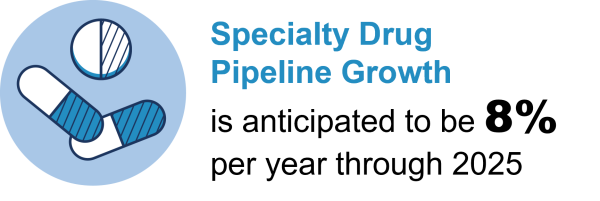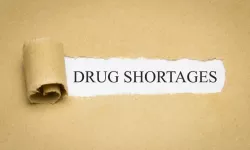In-Depth Content

The practice of specialty pharmacy is increasing, but what exactly does it mean?
Any drug can be considered “special” due to its complicated interactions with the human body. However, advanced technology drives drug development into a new domain.
New “specialty drugs” treat rare diseases, but they come with high costs, varying drug formulations, strict stability rules, and increased patient monitoring.
In fact, many community pharmacies do not have the ability, capacity, or personnel to dispense specialty medications.
That’s where specialty pharmacies come in, equipped to handle the storage, shipping, counseling, pricing, and insurance claims surrounding specialty drugs.
Specialty Pharmacy Market Growth
According to the Assistant Secretary for Planning and Evaluation, specialty pharmacy drug spending has increased by 43% from 2016 to 2021, reaching a total of $301 billion. However, only 2% of the population utilizes these medications, demonstrating the cost involved with specialty drugs.
The number of specialty drug prescriptions being filled in a non-retail pharmacy setting has increased by 40%, illustrating the growing importance of specialty pharmacies.
Specialty pharmacy has experienced significant growth in the last 10 years and is predicted to continue growing by 8% annually through 2025.
Exploring the Specialty Drug Pipeline
According to Ray Tancredi, the divisional vice president of Walgreens, 39 new drugs have the potential for FDA approval by the end of 2023, with 28 of them being specialty medications.
Among specialty drugs in clinical trials, there are 39 injectables, 37 oral medications, one inhalation drug, and one topical formulation.
These trial medications focus on the following specialty drug categories:
- Rare diseases
- Oncology
- Gene and cell therapies
- Biosimilars


The Rise of Biosimilars
Another factor to consider is the increase of biosimilars as biological drug patents are starting to expire. Biosimilar drugs closely resemble their original counterparts.
In 2021, the most used specialty drug was Humira. However, by the beginning of 2023, the market welcomed nine biosimilars for Humira, making the drug more affordable and easier for patients with arthritis and plaque psoriasis to obtain.
The expiration of patents may drive spending in the biosimilar market to reach $36 billion by 2024.
Despite increased spending, the widespread availability of biosimilars could potentially save $100 billion in costs for biologics within five years. As a result, patients everywhere will have better access to life-saving medications and therapies, further increasing prescription volume in specialty pharmacies.
Implications of Specialty Pharmacy
Specialty drugs often treat complex, chronic conditions that require timely medication to maximize patients’ outcomes. In this case, accurate deliveries are a critical component of patient care as six in 10 adults in the United States have a chronic disease, according to the CDC, while 4 in 10 in the country have two or more.
As the volume and spending are bound to increase, specialty pharmacies must be equipped with advanced technology to ensure a smooth and efficient shipping workflow.
In addition, the shift to at-home care means shipping prescriptions to patients’ homes has taken on even greater importance. This, coupled with the rapid pace of pharmacological innovation, means there are more prescriptions to ship than ever before.
Embracing the Future of Specialty Drug Distribution
Here at VPL, we are determined to provide clinically-minded solutions to the ever-changing pharmacy industry.
To that end, we created our prescription distribution, tracking, and compliance solution to ease shipping worries and increase transparency surrounding specialty medication deliveries.
For more information about how our software can help your pharmacy navigate the growth in specialty pharmacy, visit www.getvpl.com/pharmacy-solutions. This original blog post is also available at https://getvpl.com/growth-in-specialty-pharmacy-blog/.

The combination of the worsening shortage of primary care physicians (PCPs) and the valuable contributions of pharmacists during the COVID-19 pandemic have bolstered the societal case for pharmacist provider status.
According to the Health Resources & Services Administration (HRSA), there is a current shortage of 17,500 PCPs, and a study commissioned by the Association of American Medical Colleges concluded that the U.S. could experience a shortage of up to 48,000 PCPs by 2034. Moreover, the PCP shortage is even worse based on geographic distribution. Just as there are so-called “food deserts”—areas that have limited access to affordable and nutritious food—there are “PCP deserts”—places where there is one or fewer PCP for every 3,500 people, as defined by HRSA. A staggering 102 million Americans—31% of the total U.S. population—live in primary care Healthcare Professional Shortage Areas (HPSAs), and 65% of these HPSAs are in rural areas.
The Public Health Emergency (PHE) enacted by the federal government in response to the COVID-19 pandemic enabled pharmacists to provide essential services, including testing, vaccination, and treatment initiation. According to The Future of Pharmacy Care Coalition, during the pandemic pharmacists provided 350 million interventions to approximately 150 million people, in large measure due to the excellent accessibility of pharmacies—nine in 10 Americans live within five miles of a pharmacy—and the fact that patients visit their community pharmacist twice as frequently as they visit PCPs.
These two factors have generated greater bipartisan support in Washington, D.C. for pharmacist provider status, with two different legislative approaches emerging.
One approach is to mandate Medicare reimbursement of pharmacists for a narrow range of services but broadly in terms of geography. H.R. 1770, the Equitable Community Access to Pharmacist Services Act, expands Medicare to permanently include services provided by a pharmacist, including incidental services and supplies, related to testing, vaccines, and treatment for COVID-19, influenza, and certain other illnesses. As of Jan. 10, the bill had 96 cosponsors (49 Republicans, 47 Democrats), and S. 2477 is an identical bill in the Senate that has 14 cosponsors (8 Democrats, 6 Republicans).
The other approach is to mandate Medicare reimbursement of pharmacists for a broad range of services, but only in geographic areas that are underserved by PCPs. S. 1491, the Pharmacy and Medically Underserved Areas Enhancement Act, which has been brought before Congress a number of times in the past, as of Jan. 10 had 12 cosponsors (seven Democrats, four Republicans, and one Independent). As evidence of the bipartisan appeal of the bill, Sen. Tom Cotton (R-Ark.), one of the most conservative senators, and Sen. Raphael Warnock (D-Ga.), one of the most liberal senators, are among its cosponsors. The bill provides for Medicare coverage and payment at the lesser of 80% of the actual charge or 85% of the Physician Fee Schedule amount for certain pharmacist services that are furnished by a pharmacist in a HPSA and would otherwise be covered under Medicare if furnished by a physician.
The former approach as proposed by H.R. 1770/S. 2477 has garnered the most advocacy support, with backing by The Future of Pharmacy Care Coalition, whose members include the leading pharmacist and pharmacy associations, the nation’s three largest drug wholesalers, several of the largest retail pharmacy chains, and 30 hospitals and health systems.
While there was a paucity of legislation passed by Congress in 2023 and partisanship will almost assuredly continue in 2024, an election year, the aforementioned verities of the worsening PCP shortage and the value demonstrated by pharmacists during the PHE offer hope that pharmacist provider status legislation could ultimately be passed as part of a large end-of-year federal spending package.
About the author: Ken Perez, healthcare marketing, strategy and policy consultant and former Vice President of Healthcare Policy and Government Affairs for Omnicell, Inc.

The responsibility to uphold the sterile compounding standards set forth by The Joint Commission (TJC) and the updated USP Chapter <797> is paramount. The revised guidelines, which came into effect in late 2023, necessitate a proactive approach to ensure compliance and safeguard patient health.
With an eye on the latest pharmacy research and expert guidelines, below are some steps and recommendations to help ensure your hospital pharmacy is up to date on the requirements:
1.) Policy and procedure review
Begin with a thorough review and revision of your current sterile compounding policies and procedures. Ensure they are in strict alignment with the updated USP <797> guidelines. This includes clear definitions and protocols for CSP categorization, beyond-use dating, and personnel qualifications. Emphasize a culture of continuous improvement, encouraging feedback from your team members to help refine these processes.
2.) Empower your team through education and competency
Invest in providing ongoing, comprehensive training programs for your staff. The programs should cover critical aspects, such as aseptic techniques, garbing procedures, and environmental monitoring, and aligning them with the latest standards. Consider utilizing innovative training tools like simulation-based education to enhance and improve learning outcomes. Regular competency assessments are crucial to ensure that all pharmacy personnel are not just trained, but proficient.
3.) Environmental monitoring and control enhancements
Adopt a zero-tolerance policy toward lapses in environmental quality within compounding areas. Implement state-of-the-art environmental monitoring technologies to track air quality, surface cleanliness, and temperature/humidity levels in real-time. These systems can provide actionable data to prevent contamination risks.
4.) Establish a robust quality assurance framework
Quality assurance (QA) is the backbone of sterile compounding compliance. Develop a comprehensive QA program that encompasses all aspects of the compounding process, from material sourcing to final CSP verification. Regular audits, both internal and external, should be part of your QA strategy to identify and rectify compliance gaps promptly.
5.) Advanced garbing and hand hygiene protocols
Reinforce the critical importance of proper garbing and hand hygiene among your team members. Consider implementing interactive training sessions and routine competency checks to ensure adherence. Consider the adoption of newer, more effective garbing materials and hand hygiene products to further reduce contamination risks.
6.) Documentation
In the world of sterile compounding, we know that documentation is king. Maintain comprehensive, easily accessible records of all training sessions, competency assessments, environmental monitoring results, and QA audits. These records not only demonstrate compliance during TJC surveys, but also provide invaluable data for ongoing process improvements.
7.) Engaging leadership and fostering a safety culture
Active engagement from hospital leadership is essential to drive compliance initiatives and to assess the current plan. Present compelling cases for the resources needed to meet TJC requirements, emphasizing the link between compliance, patient safety, and organizational reputation. Foster a culture of safety and excellence, where every team member feels empowered to contribute to compliance efforts.
8.) Continuous improvement through feedback and innovation
Adopt an open-door policy for feedback on sterile compounding practices from your team. Encourage innovation by staying abreast of advancements in compounding technology and practices. Participate in professional forums and networks to share insights and learn from peers across the industry.
9.) Prepare for TJC surveys with mock inspections
Consider conducting regular mock TJC surveys to prepare your team and identify any potential compliance issues. These simulations should cover all aspects of the survey process, including document review, staff interviews, and direct observation of compounding activities. Use the findings to make immediate corrections and long-term improvements.
By considering and following these recommendations, you can ensure your hospital pharmacy meets the requirements set forth by TJC and USP<797>. This proactive approach to compliance will safeguard patient health, enhance the efficacy of compounded medications, and solidify your pharmacy’s reputations for healthcare excellence.
Achieving and maintaining compliance is a continuous journey that requires dedication, adaptability, and a relentless commitment to excellence. By empowering your team, investing in advanced technologies, and fostering a culture of continuous improvement, you can navigate the complexities of sterile compounding regulations and improve patient care.

Pharmacy leaders at hospitals and health systems juggle a variety of issues and activities every day. From my decades of experience, I’m familiar with the operational, clinical, financial, and regulatory responsibilities we manage. It’s challenging but rewarding.
While we can’t solve all challenges overnight, we can make progress in one area: regulatory compliance. Let’s start by focusing on accreditation. We’ll look at specific (and perhaps lesser known) standards issues I have seen surveyed, with practical strategies to prepare.
Policies and documents required for compliance
These are items I call “easy A’s,” or foundational policies you should just have in place. While they may seem like you’re just “checking a box,” if you don’t have these, your hospital may be at risk for citation. I recommend three areas to focus on:
- POLICIES: Do you have policies, SOPs, or written processes that address medication shortages, recalls, patient self-administration of drugs, investigational drug continuity, automatic stop orders, and ADRs? These are common policies that get overlooked.
- DOCUMENTS: Do you have criteria for drug selection (formulary), performance improvement plans and data?
- REGULAR REVIEW AND APPROVAL: Do you have processes in place to consistently review your formulary, LASA list, high-alert list, override lists, emergency medication supplies, policies, order sets, and standing orders?
ACTIONS TO CONSIDER:
- Policies don’t necessarily have to be full policies, but they should be written documents and must match your practice.
- Formulary demographic sheets or logs should have standardized information for each drug that is proposed for addition, and all should be filled in or marked NA to show they were considered. Work with your hospital Quality department to ensure there are medication-related PI projects being tracked and reported.
- Not all reviews are required every year but start by establishing a cadence to keep them current.
Medication security considerations
CMS says medications are secure if they cannot be accessed by unauthorized individuals. Controlled substances must be locked. These considerations are probably compliant in most of your hospital areas, but some might slip by.
- CRASH CARTS: Most of us use the breakaway numbered seals on our carts, but these ensure integrity of the drugs inside, not security. For this reason, controlled substances cannot be stored in them unless the cart is locked with a padlock, which could present a patient safety risk when trying to access emergency drugs.
- NON-CONTROLLED DRUGS: Are your crash carts under constant observation? Are they parked where they cannot be seen (like alcoves or halls)? If so, you may be at risk for non-compliance, as the seals aren’t locks and they can be opened undetected, which is a security concern.
- UNLICENSED PERSONNEL: Materials Management, EVS, and others may need to handle and/or be around non-controlled medications pursuant to performing their job duties. This is compliant, provided you have a policy that states so.
ACTIONS TO CONSIDER
- Ensure that no padlocks are used on crash carts. Any controls that might be needed during a code should be kept in separate, locked storage that can be quickly accessed.
- Placing crash carts in a locked room or in a place with close supervision will solve the challenge of unmonitored access.
- If any non-licensed individuals enter medication rooms or handle drugs as a regular activity (such as transporting cases of IV fluids), identify them in an approved policy.
Whether you’re getting ready for an accreditation survey next week or months down the road, you can never be too prepared. Compliance with the standards of accrediting bodies reduces the risk of patient harm, and isn’t that the ultimate goal?

Save money. Of all the things we can be sure we need to accomplish in our chosen profession, of this we can be sure. We are tasked with saving money. You could say that a seasoned professional would find little that would be surprising about this notion although it has brought me more clarity in how consultants are positioned to make a real difference in the provision of healthcare, in a way that I think is somewhat diminished in the “daily business”.
As we have discussed, contracting and adherence to those contracts can be passively lucrative. Developing habits that combine your distribution and Group Purchasing Organization (GPO) and being mindful of that relationship is one way to assure you keep a firm eye on the bottom line.
In tandem to the points we examined around distribution, the GPO contract itself and value adds the relationship offers is something every hospital/health system should be acutely aware of.
Are you with the right GPO? Do the blend of offerings and financial incentives mesh well with your practice and plans for the future?
There are likely contracts in place that either need to be maximized or re-negotiated. Start with the GPO and build upon the terms and conditions they have already negotiated with the companies they have vetted. This cuts out a lot of background work in that the GPO has done the hard part already.
There are often areas to operationalize group purchasing possibilities to realize shareback (the monies refunded to the I/H/C for performance stop gates) and/or contract compliance thresholds. Have you combined opportunities wherever you can? Have you shifted your clinical activities to reflect a formulary that is therapeutically sound as well as contractually beneficial? This brings more money into the health system, simply by making essential contractual points a reality in practice. This approach takes back the money that many organizations leave on the table simply by how the I/H/C interacts with the GPO.
GPO’s offer quarterly reviews. This may seem like a time suck, one in which you will learn little to effectively change any approach although this review can be invaluable if you operationalize elements of it as it pertains to your individual practice. If you are a large IDN then you have economies of scale to explore, increasing your shareback. This approach also creates a relationship with the GPO such that when it comes time for a contract roll, your representatives know what you are looking for and what you plan to explore moving forward.
The online resources of GPO's can offer an additional lever of opportunity. They can tell you how close to contract compliance you are, where you could shift activity and what that means in the aggregate. What possibilities are you not taking advantage of and how your efforts may combine with Supply Chain to maximize opportunity. Each GPO approaches this a little differently, but the general idea is the same. If you use their analytics with your own, it is possible to create a unique pharmacy program for your operation that speaks exactly to the clinical pathways you wish to explore and/or change.
We have so many obstacles in our way, fire drills every day and constant change to keep up with. Our approach to the distribution and GPO channels can lighten that load so we can turn our attention to creating programming that aligns with prudent financial moves instead of working against us as we attempt to make the most out of our vendor relationships. Bring them in close instead of putting them on the back burner to simmer.

Amidst COVID-19, the U.S. labor market, particularly in healthcare, faced substantial job vacancies (Fontinelle, 2022). The sweeping resignations of 2021 exacerbated these gaps, as competition among employers to attract workers created a cycle prompting people to seek better opportunities, as speculated by Furman (2021). An estimated 60% of healthcare support workers will leave their positions within the next five years (Loria, 2023).
Pharmacies nationwide grappled with a notable shortage of pharmacy technicians. ASHP's 2021 online surveys revealed turnover rates of 21 to 30% among hospital pharmacy technicians. Additionally, 10% of respondents reported losing up to 41% of these technicians. The surveys highlighted that over 97% of participants resorted to overtime pay and utilizing pharmacists to cover vacant technician shifts. In this piece, I will detail my initiative in revamping the pharmacy internship program to combat the technician shortage at my pharmacy, located near three esteemed pharmacy schools within a 50-mile radius.
The primary goal of the revamped program is to foster the development of pharmacy interns within the hospital pharmacy's operations. Interns primarily check unit dose medication refills in automatic dispensing cabinets while also receiving training in various pharmacy tasks such as sterile and non-sterile compounding, medication history reconciliation, crash cart drawer management, and controlled substance documentation FOR DIVERSION PREVENTION.
The pharmacy interns actively participate in the development of this internship program. Interns are responsible for compiling and updating the intern manual. They also develop a competency checklist for each intern task. A new intern is trained by those who have demonstrated competency in a given task. A new intern needs to demonstrate competency before independently performing the task.
An intern must complete the required USP 797 media-filled tests to be eligible to train in the IV room. IV-trained technicians are responsible for training interns in sterile compounding following the established sterile compounding policies. The IV room specialist technician or the IV room pharmacy coordinator is responsible for checking an intern's competency in making sterile products. The same training methodology is used for training interns in performing other tasks.
Encouragement is given to interns to undertake technical writing projects to hone their skills. Those inclined towards technology can learn about system integration, while those interested in hospital pharmacy management can engage in workflow and inventory enhancement projects. Two lead pharmacy interns oversee scheduling, training, and competency checks of other interns, as well as organize quarterly intern meetings, thereby refining their leadership skills.
A well-crafted pharmacy internship program not only addresses technician shortages but also equips pharmacy interns for future hospital pharmacy careers. Over the past three years, our pharmacy intern team has burgeoned from 6 to 18 members, at one point helping cover up to seven open technician positions. Not only do pharmacy interns help maintain a smooth pharmacy operation by filling in open shifts, but they also help reduce overtime pay and burnout among staff.

It's amazing how quickly an industry can change. Thinking back to the early 2000s, hospital pharmacy procurement had successfully transitioned from a break-bulk/surplus purchasing style to just-in-time (JIT) purchasing and maintaining minimum inventory on the shelf.
AmerisourceBergen, McKesson, and Cardinal Health (the "big 3") had consolidated much of the wholesale and distribution industry and made improvements to their operations, largely alleviating the pressure of hospitals to maintain a large stock of medications. Pharmacy buyers, in turn, spent a good part of their day calculating inventory turns and working to get them as high as possible, only ordering what they needed to maintain a 72-96-hour on-hand inventory.
The success and capital efficiency of the JIT model along with continued adoption of pharmacy automation helped to reduce the need for medication storage space in most hospitals — so much so that rooms that had been used for storing medication were repurposed or taken by other departments. Health systems were confident that they could rely upon their pharmacy supply chain to distribute the medications they needed across their system in a timely manner, and central operations were focused on repackaging, IV compounding, and other labor-over-drug-cost initiatives where utilizing technician labor could bring medication costs down.
Forced to Adopt a Hybrid Model
Fast forwarding to today, confidence in JIT purchasing has flagged as medication availability disruptions have increased. Recalls, manufacturer shutdowns, bankruptcies, overseas logistics challenges, and even simple market economics have led to major medication outages and pharmacies simply running out of drugs.
This shift in stability is motivating hospitals and buyers to look for ways to create supply guarantees or reserve stock for vital medications, many times opting for additional on-site physical inventory — the exact opposite direction from JIT models. We're seeing a growing number of hospital systems building their own warehouses and taking on the burden of self-distribution to ensure additional days of drug on hand.
Compounding and repackaging efforts have seen a similar reversal of strategy. Given the severe labor shortages in the hospital pharmacy space, many hospitals are eager for a partnership with a 503B compounding pharmacy to outsource labor-intensive IV admixture processes. Similarly, outsourcing repackaging efforts or simply purchasing higher cost pre-mix products over products that require manual labor for manipulation is almost a foregone conclusion. The additional cost of medications is moot if there is no one available to do the work.
Repackaging and compounding channels have shown their own vulnerabilities as quality, supply, and lead-time issues have plagued the industry. In past years, the decision to "build versus buy" an IV product could be thoughtfully approached, and the transition planned and plotted. These days, this decision to insource or outsource a product is immediate and driven by unpredictable factors in both medication and labor availability alongside recurring 503B facility shutdowns.
One thing that has remained consistent: the mindset of reducing costs by better utilizing people and technology is as salient today as it was 20 years ago. Pressure on hospital pharmacy to "do more with less" has always been there, but the context of "supplying more medications at lower costs" has shifted to "performing more services with fewer available people."
The Greatly Changed — and Expanded — Role of Pharmacy Procurement
With these developments, pharmacy procurement jobs have exploded in complexity. Instead of simply walking the shelves, identifying gaps in inventory, and filling in the blanks, today's pharmacy buyer is burdened with managing questions like: Will this hurt my group purchasing organization compliance? Is this product built in our systems? Does this medication need specific accommodations for 340B issues? Are the correct contracts and prices loaded for our class of trade? Will we meet our committed volumes and achieve tier discounts?
A pharmacy buyer today is not only the inventory manager but an operator with proficiency in regulatory and contractual obligations, dynamic inventory flows, channel relationship management, analytics, and business intelligence. With so many responsibilities, it's become more difficult to track where money is moving, and more challenging to keep up with market dynamics that affect purchasing decisions and acquisition.
For these reasons, the role of buyer is no longer a simple add-on responsibility for a technician or pharmacist to complete in their downtime. Despite the lack of formal training options in the market, procurement has become a specialized position requiring significant investments in training, recruiting, and retention. Centralized purchasing — a model health system pharmacies are largely moving toward as hospitals consolidate — places these duties on dedicated buyers to ensure optimal procurement and distribution of drugs. This model has demonstrated that the appropriate authority and accountability invested in proficient pharmacy buyers can result in ongoing and meaningful outcomes at significant scale.
Achieving An Optimal Balance Between People and Solutions
While pharmacy procurement has become more complex over these last two decades, we are seeing health systems navigate these increased responsibilities successfully leveraging technology and partnerships. By identifying solutions that empower a leaner pharmacy team and help them to prioritize and complete their work efficiently, hospitals can eliminate much of the menial analysis from a buyer's job and help to focus on the 20% that really matters. When considering approaches in this space, there are a few approaches seen most commonly.
The most traditional approach is to use outsourced labor to complete the lower impact work. In the growing field of pharmacy procurement where expertise is hard to come by, there is tremendous value in the perspective gained from working with multiple health systems, but the questions remain: How do you ensure third parties work exclusively in your interest? How fast can you turn around someone else's employee to focus on your highest need in a market where hours matter?
Depending on the firm, there may be inherent conflicts between an outsourcing entity's financial interests and those of the health system. Finding objective and impartial assistance can be difficult, and the higher the degree of dependency on external talent, the higher the chances are that system-specific decisions and safeguards are at risk. Loss of control, lack of accountability, and the inability to shift priorities effectively, especially in a health system pharmacy, can feel like a tremendous disadvantage in a fast-paced market.
On the other end of the spectrum, we hear of "total automation" (i.e., "single pane of glass") solutions touted for so many processes, but more often than not these solutions require tremendous technical resources to implement and maintain. For large teams working in revenue cycle, the ratio of technical resource to claims processors have been advantageous. In pharmacy, we've more often seen these additional technical responsibilities piled onto an already-busy EHR, pharmacy IT, or pharmacy operations teams, and the additional channels needed to push change causes delays in execution. If you perform any critical analysis to select medications for a hospital, someone will have to teach the machine why you choose the way you do and how to handle the many exceptions you consider along the way.
Rather than subsidizing labor with low-accountability outsourcing or attempting to replace it entirely with high-complexity, high-maintenance total automation, the key to making progress while maintaining ownership has been identifying crucial touchpoints that cannot or should not be performed by an external vendor or technology and helping employees execute on these touchpoints rapidly with high-context guidance and oversight.
This is not a new idea - to reduce fraud, the group at PayPal was able to scale using automation to screen billions of dollars in transactions, identify those with the highest likelihood of fraud, and pass those transactions to a team for manual review. More recently, Latent Health advertises using artificial intelligence to identify and automate steps for prior authorization that are trivial or duplicative, leaving just those components that require trusted clinician review. Claims processing automation tools that forward exception cases to specialist teams have made tremendous impacts for health systems and spawned several publicly traded and successful companies in the process.
For all these tools, it's all about getting the information that needs to be "touched" to the people who need to see it, while ensuring those same people don't spend valuable time slogging through things they do not need to see. When done right, this makes the people involved more useful, enables them to use more of their valuable skillset, and gives them ownership of these important processes. For the complex, volatile world of pharmacy purchasing, where flexibility, context, and timeliness are paramount for getting medications safely to your patients, choosing the correct path on your quest to "do more with less" will pay significant dividends.

Drug shortages have existed for many decades but not to the extreme that they are today. The pandemic (COVID) and how we treated patients, highlighted the extreme vulnerability of the whole drug supply chain in the United States, especially for generic injectable drugs, which are some of the most frequently used drugs in a hospital setting of patient care, from neuromuscular blockers, anti-infectives and oncology drugs. We rely on some of the cheapest drugs and we count on them to be available, to provide patient care for various diseases and indications and to support patient care service lines, such as oncology and pediatrics.
We need to remember, that the generic drugs that are in short supply, are classified as “small molecule drugs” and not “branded drugs or biosimilars” and some, maybe generic for 25 years or more. Branded Drug Companies own the API source/supply for their small molecule drugs, if they have the patent/NDA. Generic drug companies don’t have medical science liaisons (MSLs) and normally, don’t do any research to expand the FDA approved indication of a drug or develop a different vial size, when they decide to manufacture the generic (this requires a separate ANDA that can take up to 2 years). Generic Drug Companies file for an ANDA (Abbreviated New Drug Application) with the FDA and have their own professional organization, the Generic Pharmaceutical Association, representing them in Washington DC and with the FDA.
As we enter 2024, there are still no solutions that have been implemented policy wise, by the FDA and legislatively, to address the Drug Shortage issue, and the same questions. There have been many meetings and hearings in Washington DC being held with the FDA and Committees, such as Energy and Commerce, with representatives from many different professional organizations, clinicians who treat patients, and even patients and their families, impacted by drug shortages, but still no actions, policies, or legislation being presented for review and approval, to solve the drug shortage crisis. There are discussions about the role of the FDA in the approval process of generic drugs, as well as the role of each generic manufacturer and their professional organization, the Generic Pharmaceutical Association. Drug shortages have been blamed on drug costs being too low for generic drug companies to sustain a profit (race to the bottom), to API shortages and country of API origin, to lack of quality in manufacturing (cGMP), geographical location of manufacturing facilities and exposure to natural disasters, lack of FDA inspections or timely inspections, lack of communication to the FDA on a drug shortage by generic companies and the reason for the drug shortage and the supply chain. Generic drugs are not only purchased and distributed to hospitals, but physician practices (e.g. oncology), 503Bs for compounding (sterile to sterile), private payer infusion companies and various home infusion companies. Sometimes generic drugs end up in what we call the grey market. A more recent concern that has arisen, is the impact of geo-political issues on the global supply chain of drugs.
To develop long-term solutions, there needs to be an understanding of the whole process/steps in developing a generic drug and address each step accordingly with a solution, until it gets to the end user to administer to a patient. Some of the legislation and changes being recommended as solutions, regarding generic drugs, can and will impact the drug supply chain, availability of generic drugs and ability to order drugs to treat patients.
One program being established by the Center for Drug Evaluation and Research (CDER) is the Quality Management Maturity (QMM) Program. The Goals of QMM are 1. Foster a strong quality culture mindset. 2. Recognize establishments that have advanced quality management practices and acknowledge establishments that strive to continually improve quality management practices. 3. Identify areas where quality management practices can be enhanced and provide suggestions for growth opportunities. 4. Minimize risks to product availability to assure reliable market supply.
A second program is Senate Bill S.2510, the RAPID Reserve Act (Rolling Active Pharmaceutical Ingredient and Drug Reserve Act”, which addresses building and maintaining reserves of critical medications and their key ingredients, including API (active pharmaceutical ingredients), and reducing reliance on foreign drug manufacturers.
The Pediatric Cancer Drug Supply Act of 2024 was recently proposed and directs the U.S. Department of Health and Human Services (HHS) to establish a program to create a reserve supply of essential pediatric cancer drugs. HHS would contract with eligible drug manufacturers to produce a stockpile of the most essential pediatric cancer drugs. As part of the contract, drug manufacturers would receive payments from HHS based on the quantity and cost of pediatric cancer drugs held in reserve. HHS would have authority to order manufacturers to distribute drugs from the buffer stocks into the commercial market to alleviate or prevent drug shortages.
As we continue into 2024 my thought is that there will be some reasonable discussion, decisions and appropriate solutions being approved by the FDA and legislatively, so we can get back to delivering patient care, sooner, rather than later. If there is no drug, there is no Value!

Essential Medicine Shortages have become commonplace throughout the supply chain. This year ASHP reported that 99% of hospital pharmacists encounter more than one drug shortage a day. 2023 was a dire year for drug shortages. Patients from around the country faced a 10 year high of the number of medicines in shortage and they needed help.
A bankruptcy, a quality assurance event, and a tornado caused major disruption, closures, and impact at 3 separate manufacturing plants. These events spotlighted the urgent need to build resiliency and collaboration into the entire supply chain. The pharmaceutical supply chain is fragile. Any setback or disruptions can cause a ripple effect, severely impacting patients. A broken and brittle supply chain cannot fill the physician's hands that save the lives of our people. During each one of these events, Angels for Change was there fostering patient first
solutions, collaboration, transparency, and redundancy to mitigate the shortage and create the resilient healthcare supply chain our citizens deserve.
Angels for Change (A4C) is the only 501c3 volunteer supported, patient advocacy organization on a mission to end drug shortage through advocacy, awareness, and a resilient supply chain. Laura Bray founded A4C in 2019 after her own child faced three life-saving drug shortages in nine months of pediatric cancer treatment. Each day, A4C advocates on behalf of patients, physicians, and pharmacists in a life-saving drug shortage, while building relationships with members of the pharmaceutical supply chain and policy makers to end drug shortages. We take direct calls from those in a shortage crisis and connect them to supply through our Inventory
Sharing Network. We answer every call. We leave no patient behind. This work has given us a unique view into the supply chain. While it is brittle and broken, it is also filled with supply chain experts and front line care teams willing to perform herculean efforts to treat their patients and save lives. This supply chain is made up of so many champions that can and will unite to end this crisis.
In May of 2022, founder Laura Bray attended Health Connect Partners as a panelist to share about the drug shortage crisis. She discussed real patient drug shortage stories and practical solutions to end drug shortages, such as the launching of the End Drug Shortages Alliance (EDSA) and project PROTECT.

The 340B Program provides eligible hospitals and health systems resources not associated with federal subsidy, to administer comprehensive healthcare to patients and communities disproportionately affected by social, economic and environmental disparities. The program requires drug manufacturers participating in Medicare and Medicaid to provide outpatient drugs to covered entities at significantly reduced prices.
The last three years have placed extraordinary strains on hospitals, and for many smaller hospitals, the 340B program is critical to survival. Without 340B program savings, many smaller hospitals might need to lay off workers and shutter needed programs, such as those that help to detect and treat patients suffering from chronic conditions. Consequently, underserved populations will need to travel further away to receive care.
For smaller hospitals and those serving rural communities, many of which do not operate their own outpatient pharmacy, the only avenue for patients to access drugs covered under the 340B program is through a contract pharmacy arrangement. However, there are several disadvantages to relying solely on contract pharmacies to meet patients’ specialty medication needs. With a robust in-house specialty pharmacy program utilizing 340B savings, financially challenged hospitals can recover funds quickly while reducing the administrative burden on staff and improving patient outcomes. Could more small and rural hospitals fully utilize the 340B drug pricing program?
Perceived Barriers
Some of the perceived barriers for smaller hospitals to open an outpatient pharmacy and recognize the most benefits out of 340B include:
- The belief that starting their own specialty pharmacy is too expensive, risky or complicated considering the perceived restrictions.
- The myth that there is a threshold of pharmacy spend required.
- The myth that specialty pharmacy programs require a large patient base of specialties such as oncology.
Disadvantages of Contract Pharmacy Reliance
Contract pharmacy restrictions that manufacturers placed on 340B hospitals have limited eligible health systems from reinvesting 340B funding into improving their services and communities. These increasing manufacturer restrictions on specialty medications make owning a specialty pharmacy a critical step toward maximizing savings. When dispensed in-house, the hospital saves money on fees it otherwise would pay to the contracted pharmacies. Community-based health systems, especially those serving rural communities, find it difficult to implement integrated specialty pharmacy programs due to payer or PBM restrictions, drug distribution limitations and absence of the necessary resources and infrastructure.
This results in specialty prescriptions being filled by external pharmacies that are unaffiliated with the health system leading to care fragmentation and inconvenience and frustration for patients. Health systems that do not provide retail or specialty pharmacy services also miss the opportunity to achieve healthy financial margins that are often associated with dispensing specialty medications. The improved margin opportunity for health systems who choose to own their own pharmacy is significant and can allow more hospitals to keep their doors open, while providing an expanded service to patients in a familiar care setting.
Overcoming Barriers with Data
When determining if opening an in-house specialty pharmacy is a good fit, there are many unknowns. It is necessary to understand the landscape of the community, the behaviors and demographics of the patient populations and have a long-range view for the needs of the health system and community. Anticipating industry and pharmaceutical pipeline trends provides an additional advantage in projecting the long-term growth and viability of the program. Executives should have access to their organization’s data and the resources needed to analyze the benefit of this investment. Many hospitals and health systems turn to a specialty pharmacy services company with expertise in these assessments for detailed analyses.
Opening an in-house specialty pharmacy helps hospitals provide superior clinical care, increase revenue and better support vulnerable communities. Incorporating specialty pharmacy services and utilizing the 340B program within the hospital’s clinical programs greatly enhances the patient and provider experience -- delivering an integrated program that drives revenue and reduces the total cost of care.